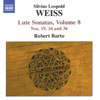Weiss Lute Sonatas, Vol 8
Elegant and discerning playing you’ll be happy to return to
View record and artist detailsRecord and Artist Details
Composer or Director: Silvius Leopold Weiss
Genre:
Instrumental
Label: Naxos
Magazine Review Date: 4/2007
Media Format: CD or Download
Media Runtime: 63
Mastering:
Stereo
DDD
Catalogue Number: 8 570109

Tracks:
| Composition | Artist Credit |
|---|---|
| Sonata No 36 |
Silvius Leopold Weiss, Composer
Robert Barto, Lute Silvius Leopold Weiss, Composer |
| Sonata No 19 |
Silvius Leopold Weiss, Composer
Robert Barto, Lute Silvius Leopold Weiss, Composer |
| Sonata No 34 |
Silvius Leopold Weiss, Composer
Robert Barto, Lute Silvius Leopold Weiss, Composer |
Author: William Yeoman
It’s a curious fact that the sarabande’s originally overt eroticism has never been entirely eradicated. Perhaps it’s the same for any dance movement in your typical Baroque suite, but in the sarabande especially, sex and death always lurk just beneath the surface. With Weiss, this is accentuated by a provocative transparency in the writing and the melancholy timbre of the lute; with Robert Barto, it’s in the way he seduces you by subtly manipulating patterns of tension and release in the music to reveal the body beneath the garments.
Here Barto uses three of Weiss’s sonatas (suites) to form one “mega-sonata”. The tensions inherent in the outer suites, both in D minor, are momentarily suspended in the central Sonata No 19 in F major – a key that, as Tim Crawford points out in his excellent booklet-notes, was in the Baroque period identified with peace and serenity. Sonata No 36, which opens the disc, suggests what’s to come: an F major Sarabande provides an oasis amid the minor-key turbulence, while the Bourée sounds positively agitated in comparison with those found in the following suites. The more plain-speaking Sonata No 34, which brings the disc to a close, has been a long-time favourite with classical guitarists.
As with the previous volumes in this series, Barto doesn’t overburden Weiss’s music with exaggerated phrasing or excessive ornamentation. And his tempi always feel just right. As a result, you’re more likely to return to these elegant, revealing performances again and again.
Here Barto uses three of Weiss’s sonatas (suites) to form one “mega-sonata”. The tensions inherent in the outer suites, both in D minor, are momentarily suspended in the central Sonata No 19 in F major – a key that, as Tim Crawford points out in his excellent booklet-notes, was in the Baroque period identified with peace and serenity. Sonata No 36, which opens the disc, suggests what’s to come: an F major Sarabande provides an oasis amid the minor-key turbulence, while the Bourée sounds positively agitated in comparison with those found in the following suites. The more plain-speaking Sonata No 34, which brings the disc to a close, has been a long-time favourite with classical guitarists.
As with the previous volumes in this series, Barto doesn’t overburden Weiss’s music with exaggerated phrasing or excessive ornamentation. And his tempi always feel just right. As a result, you’re more likely to return to these elegant, revealing performances again and again.
Discover the world's largest classical music catalogue with Presto Music.

Gramophone Digital Club
- Digital Edition
- Digital Archive
- Reviews Database
- Full website access
From £8.75 / month
Subscribe
Gramophone Full Club
- Print Edition
- Digital Edition
- Digital Archive
- Reviews Database
- Full website access
From £11.00 / month
Subscribe
If you are a library, university or other organisation that would be interested in an institutional subscription to Gramophone please click here for further information.




